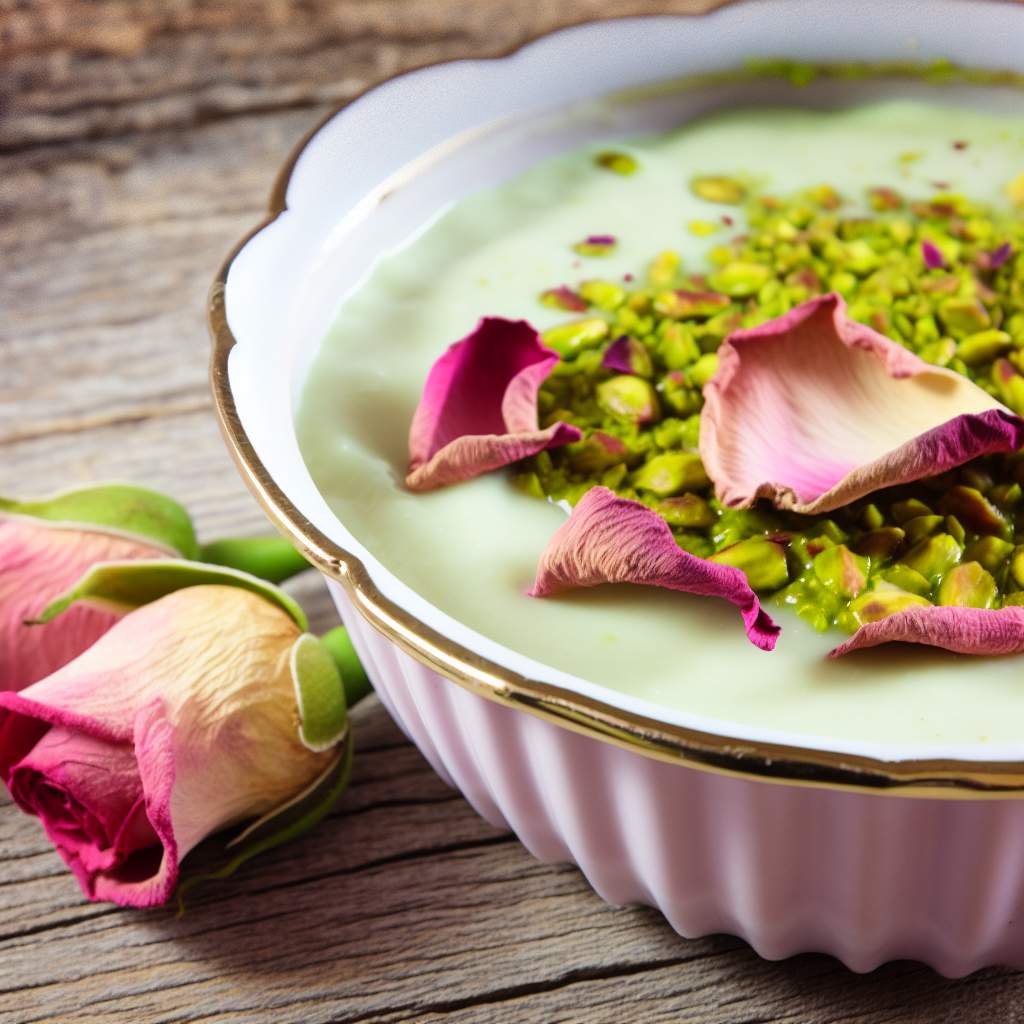There’s something utterly enchanting about the combination of pistachios and rosewater that transports you straight to the vibrant markets of the Middle East. This Pistachio Rosewater Pudding is my tribute to those magical flavors – a silky, luxurious dessert that balances nutty richness with delicate floral notes. It’s the kind of treat that makes everyday moments feel special, yet it’s surprisingly simple to create in your own kitchen. The beautiful pale green color flecked with bits of emerald pistachio creates a visual feast before you even take your first spoonful.
I first discovered this dessert during a cooking workshop with a Lebanese chef who spoke of how this pudding (or “muhallabiah” as it’s traditionally known) was served during celebrations and family gatherings. The way her eyes lit up when describing how her grandmother would carefully sprinkle rose petals and crushed pistachios on top just before serving made me realize this wasn’t just food – it was love, tradition, and artistry combined. I’ve adapted the recipe slightly for modern kitchens without losing any of that authentic charm. Whether you’re hosting an elaborate dinner party or simply craving something special on a quiet evening, this pudding delivers a moment of pure bliss.
Ingredients
- 4 cups whole milk
- 1/2 cup cornstarch
- 3/4 cup granulated sugar
- 1 cup shelled pistachios, plus extra for garnish
- 2-3 tablespoons rosewater (adjust according to preference)
- 1/4 teaspoon ground cardamom
- Pinch of salt
- 1 tablespoon unsalted butter
- Dried rose petals for garnish (optional)
- Honey for drizzling (optional)
Instructions
1. Begin by preparing your pistachios. Reserve about 2 tablespoons for the final garnish, then finely grind the remaining pistachios in a food processor until they reach a fine, sandy texture. Be careful not to over-process into a paste – we’re looking for ground pistachios, not pistachio butter!
2. In a large bowl, whisk 1 cup of the milk with the cornstarch until completely smooth with no lumps. This mixture will act as our thickening agent, so it’s important to get it perfectly smooth now to avoid any lumps in the final pudding.
3. Pour the remaining 3 cups of milk into a heavy-bottomed saucepan. Add the sugar, ground cardamom, and salt. Heat over medium heat, stirring occasionally until the sugar has completely dissolved and the milk is hot but not boiling.
4. Slowly pour the cornstarch mixture into the hot milk, whisking constantly to prevent lumps. Continue to cook over medium heat, whisking continuously, until the mixture thickens enough to coat the back of a spoon – about 5-7 minutes. You’ll notice it transform from a thin liquid to a beautiful custard-like consistency.
5. Reduce the heat to low and add the ground pistachios, stirring to incorporate them evenly throughout the pudding. Continue cooking for another 2-3 minutes to allow the pistachio flavor to infuse into the mixture. The pudding should now take on a gentle green hue – a preview of the delicate flavor to come.
6. Remove from heat and stir in the butter until melted. The butter adds a subtle richness and silky finish to the pudding that elevates it from good to extraordinary. Allow the mixture to cool slightly for about 5 minutes – just enough to take the edge off the heat but still keep it warm.
7. Now for the magic touch – add the rosewater gradually, tasting as you go. Rosewater can vary significantly in strength between brands, so start with 2 tablespoons and adjust according to your preference. The aroma should be present but delicate – like walking through a garden of roses rather than being overwhelmed by perfume.
8. Pour the pudding into individual serving dishes or one large serving bowl. The traditional presentation uses shallow dishes to allow for proper cooling and to create more surface area for the beautiful garnishes to come. Tap the dishes gently on the counter to remove any air bubbles.
9. Press a piece of plastic wrap directly onto the surface of the pudding to prevent a skin from forming. Refrigerate for at least 4 hours, or preferably overnight, to allow the pudding to set completely and for the flavors to meld together harmoniously.
10. Before serving, roughly chop the reserved pistachios. Remove the plastic wrap and garnish the pudding with the chopped pistachios and, if using, a light sprinkle of dried rose petals. For an extra touch of sweetness and visual appeal, drizzle with a small amount of honey.
The Cultural Significance Behind the Dish
Puddings made with milk, nuts, and floral waters have been a cornerstone of Middle Eastern cuisine for centuries. What makes this dessert particularly special is how it represents the region’s mastery of subtle, complex flavors. The pistachios aren’t just a garnish – they’re integral to the dish, providing both texture and a rich earthiness that anchors the ethereal floral notes of the rosewater. In many Middle Eastern households, offering this pudding to guests is a gesture of hospitality and care, often reserved for special occasions and celebrations.
Serving Suggestions
This Pistachio Rosewater Pudding is traditionally enjoyed on its own, allowing the delicate flavors to shine. However, it pairs beautifully with a small cup of strong Turkish or Arabic coffee, the bitter notes of the coffee creating a perfect counterpoint to the sweet, floral pudding. For a more substantial dessert experience, serve with a small plate of crisp butter cookies or delicate almond tuiles. If serving for a special occasion, consider placing each individual pudding on a small plate surrounded by fresh berries or sliced figs when in season – the tartness of the fruit provides a wonderful contrast to the creamy sweetness of the pudding.
Make-Ahead and Storage Tips
One of the many virtues of this pudding is that it must be made ahead, making it perfect for entertaining. The pudding will keep beautifully in the refrigerator for up to three days – simply keep it covered with plastic wrap until ready to serve. I find the flavor is actually at its peak on the second day, when the pistachio and rosewater have fully infused into the creamy base. Just hold off on adding the garnishes until right before serving to maintain their texture and visual appeal. Unfortunately, this pudding doesn’t freeze well, as the delicate structure breaks down upon thawing, resulting in a grainy texture.
Final Thoughts
What I love most about this Pistachio Rosewater Pudding is how it transforms humble ingredients into something truly extraordinary. It reminds us that dessert doesn’t always need to be complicated or over-the-top to be memorable – sometimes the most beautiful experiences come from perfectly balanced, simple pleasures. As you take your first spoonful, close your eyes and let the flavors transport you to sun-drenched courtyards and jasmine-scented evenings. That moment of culinary escape is what makes cooking and sharing food one of life’s greatest joys. Whether you’re exploring Middle Eastern cuisine for the first time or reconnecting with familiar flavors, this pudding offers a little piece of edible poetry that I hope brings as much joy to your table as it has to mine.
Nutrition Information (per serving)
Calories: 275 | Fat: 12g | Carbohydrates: 38g | Protein: 7g | Serves: 6

